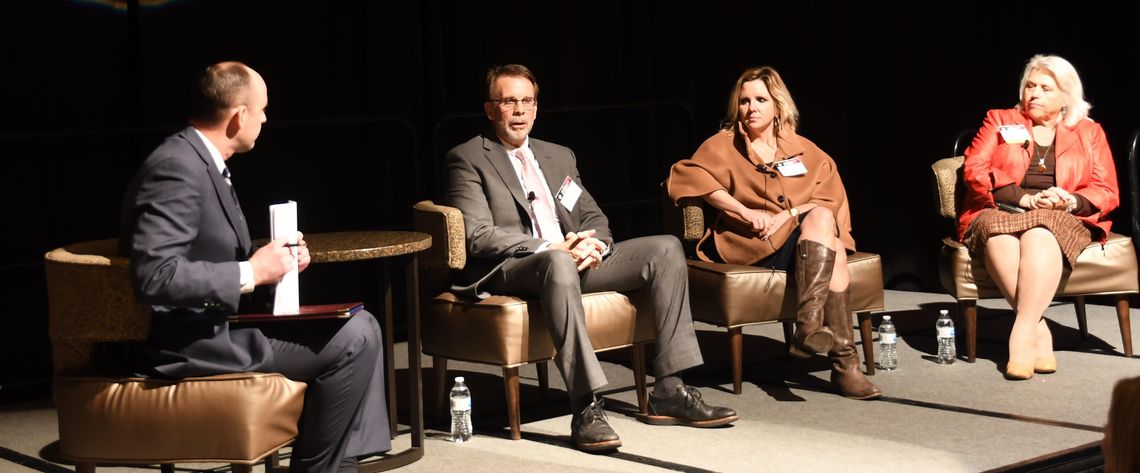Cooperation and communication were the themes in a panel discussion on regional transportation projects, priorities and concerns at the second annual San Marcos Chamber of Commerce Transportation Summit.
“We must look past tomorrow and focus on the long game,” Chamber President Jason Mock said during introductory comments at the event, which was held Friday at the San Marcos Conference Center.
Airport update
The summit began with a presentation from Jim Wimberly of Texas Aviation Partners, the company that manages the San Marcos Regional Airport. Wimberly talked about the airport’s features, including three runways; a Federal Aviation Administration air control tower; 14 businesses including firms that provide fueling, car rental and other services; and 400 acres available for future development. Traffic at the airport averages about 178 takeoffs and landings per day, Wimberly said.
Wimberly also noted that the San Marcos airport is the only airport in the state that has FAA designation as a reliever airport for two international airports: San Antonio and Austin-Bergstrom.
“When traffic reaches a certain point … we become the backup airport for those two,” he said. “It helps us with federal funds to be designated a reliever airport.”
A Texas Department of Transportation (TxDOT) economic impact study of the airport showed that its impact has grown significantly since 2010, when Texas Aviation Partners took over management of the airport.
“It’s doubled from $44 million in 2010 to $82 million last year,” he said.
Projects in the work at the airport include an updated master plan, the expansion of Berry Aviation, the “Go Wheels Up! Texas” concert event scheduled for May, and a $10 million rehabilitation of the longest taxiway, Wimberly said.
Regional roadways
Mock moderated the panel discussion at the summit, which focused on transportation issues in Central Texas and particularly how to improve transportation as the region’s population grows. San Marcos Director of Engineering Laurie Moyer, TxDOT Austin District Engineer Terry McCoy and Central Texas Regional Mobility Authority (CTRMA) External Affairs Director Dee Anne Heath fielded questions about congestion, project costs, how different agencies work together, how the business community can get involved and stay informed, and the different factors related to transportation.
The first question was about the increasing congestion on local and major thoroughfares as more people move to Hays County and Austin.
“What’s being done to ensure we can get from Point A to Point B?” Mock asked.
“It’s a challenge to try to keep up,” McCoy said. “What we do is work with partners — partners you see up here on stage and partners who aren’t with us today.”
McCoy said those partnerships involve looking at growth and exploring ways to cooperate and deliver projects reliably and efficiently while maintaining the current system.
“We appreciate all the support, all the cooperation … that helps us make these decisions,” he said.
Heath also emphasized the need for cooperation.
“You really have to have all the tools in the toolbox,” she said. “What we try to do at CTRMA is try to educate everybody about all of those tools and why they’re important and make sure that nobody takes them away from us.”
She cited elements like toll roads, increased capacity, shared use and transit options.
“All of these elements are critical,” she said.
Heath also cited other elements that affect transportation but might not be as obvious, such as employers allowing flex time and telecommuting to change people’s driving habits.
“It really has to be everything,” she said.
Moyer said that growth is at such a fast pace, “We can’t build roads fast enough for the number of people that are moving in.”
She cited the work that the city has done in partnership with TxDOT and the process involved in planning and permitting.
“It’s a good process, but it’s a long process and things change during the process,” she said. “So I think one of the big challenges that we have … is coordination and looking at ways to make what we have operate the most efficiently.”
Looking at the future
Heath said that she grew up in Austin and has seen how growth affected transportation there.
“My dad would say, ‘Don’t build it, and they won’t come.’ He was one of those,” she said. “Well’ they’re here.”
She said that it is impossible to know what the future will look like, but that innovative approaches will have to be taken. She noted that tools like apps, ridesharing and other technologies and projects can be used to help prepare for and cope with the future — elements that “go beyond concrete and steel.”
Moyer emphasized the importance of planning and of not letting plans stagnate.
“You update the plan, you consistently update,” she said.
She also noted the importance of regional planning — the kinds of efforts made by metropolitan planning organizations in Austin and San Antonio.
“And we’re sitting right here in that sweet spot,” she said.
Heath said that the regional partnerships play a crucial part.
“It is so important to bring all the parties to the table,” including the citizens, she said. “... The beauty of this region is we really do have great partnerships with all these people.”
Mock asked the panel a perennial question of people living in the corridor: When will Interstate 35 be finished?
“It’ll never be finished,” McCoy said at first.
He noted that at some point, the state will have done everything there is to do with the interstate and other corridors will have to be explored because there simply will not be enough room on I-35 for everyone using it.
Until then, though, work will continue on the interstate until “we’ve built everything we can build on I-35,” he said.
Mock also asked what the business community can do to get involved and informed, and Heath said that events like the transportation summit are great opportunities for just that. She emphasized the need for ongoing communication with the entities involved in transportation planning.
“The communication has to be ongoing and frequent,” she said.
Heath also noted that a lot of people might not think of transportation as a high priority in their lives, though it has more of an effect than many realize.
“It’s about improving your life on a daily basis,” she said.







